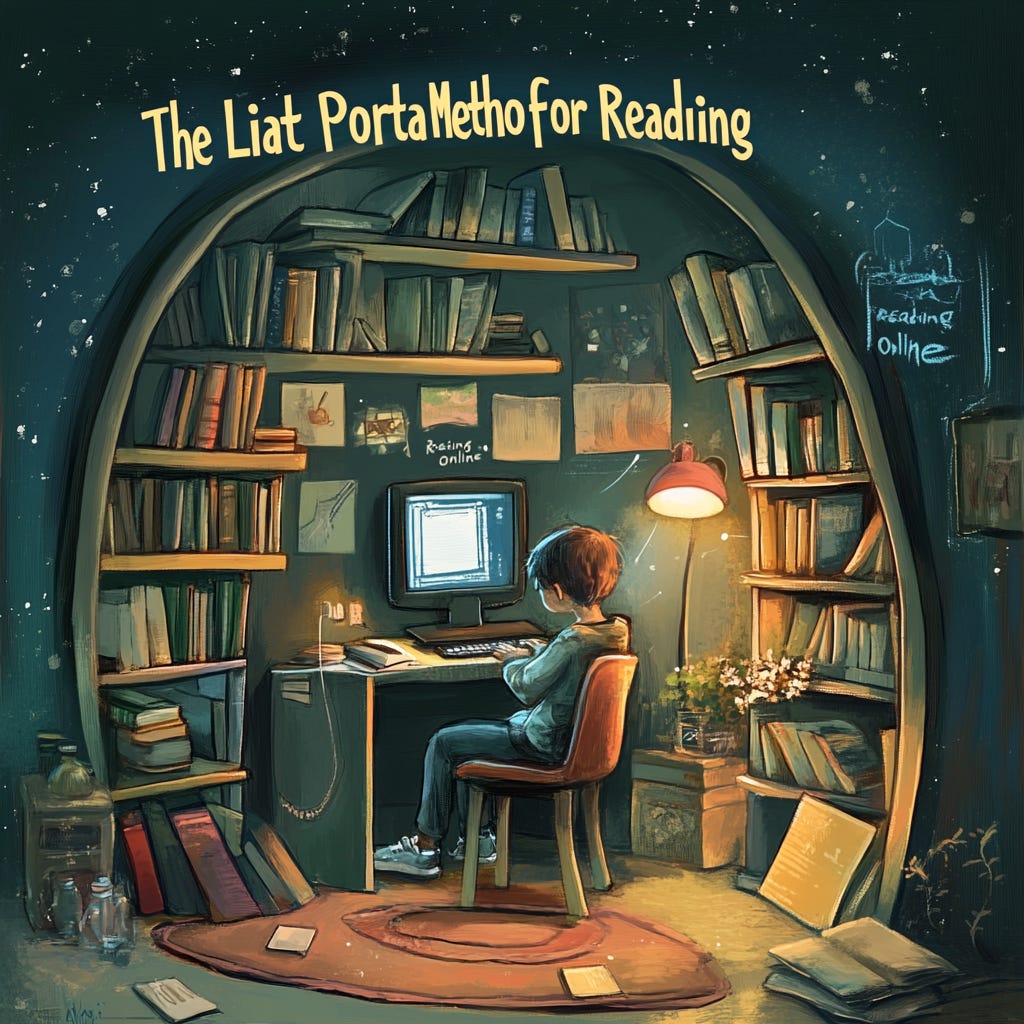The Liat Portal Method for Reading: A New Way to Read Online
A Story Unfolding Across Timelines.
Current Time.
Most people read online the wrong way. The Liat Portal Method changes that by teaching digital reading skills, source verification, and online literacy.
Have You Heard About The Liat Portal Method for Reading?
Probably not. So now is the perfect opportunity to learn what the hell it means. Just giving you a heads-up, this reading method is the foundation of compulsory education reading in the digital era. So, let’s take it one step at a time and start with the reading method.
What’s the Problem? We’ve Been Reading Online the Wrong Way
Reading in the digital era is not the same as reading a book or a newspaper. However, we still teach people to read text on screens as if they were reading from paper. Unfortunately, that doesn’t work anymore.
Why? Because online reading has different rules!
A printed book doesn’t have links pulling you in different directions.
A printed book doesn’t have real-time updates changing the information overnight.
A printed book doesn’t require you to evaluate the source every time you turn the page.
But online? Everything you read is interconnected, constantly shifting, and requires verification repeatedly.
Despite this, no one has ever defined or developed a structured way to teach people how to read online. If you raise your eyebrows and don’t understand what I am talking about, you are exactly in the right place.
That’s where The Liat Portal Method for Reading comes in.
The Liat Portal Method: A New Way to Read Online
The Liat Portal Method describes a reading technique for the digital era. It’s not just reading text in English, as schools have been teaching and still teach today. This method defines fundamental terms for public use to establish a common global agreement on reading online, to understand what data sources exist, how to use them properly, and which ones to use in a specific context.
This method changes the way we approach reading in the digital age.
It establishes clear categories for online information.
It helps readers instantly identify the credibility of a source.
It creates a structured approach to evaluating knowledge before believing it.
Right now, people click on links without any visual indication of where they lead. They read information without questioning its credibility. They trust everything or distrust everything, which is bad either way.
The Liat Portal Method fixes this by creating a structured way to classify and process digital information.
How Does It Work? Categorizing Links for Smarter Reading
The first step is to visually distinguish different types of sources so readers can instantly know what they’re clicking on.
The Way We Read Online Now
Let’s start with an example and say you read an article and see this sentence:
"Recent studies show that coffee improves brain function." (Source: Click Here)
You have no idea if that link leads to:
A peer-reviewed study
A random blog post
A clickbait news site
A TikTok influencer’s opinion
Right now, every link looks the same, so people either blindly trust it or never click it at all.
For the smartass who’s going to say, "If you hover, you see the address," - well, not every website has this functionality, and most people don’t know how to do that. Knowing that positions you in the top educated group in the world, while about 90 percent of the global population has no idea how to do that.
After Applying The Liat Portal Method for Reading
Now, let’s imagine reading the same sentence but with a visual indicator that categorizes the source:
"Recent studies show that coffee improves brain function." (Source: [Academic Article] 📘)
Now, without even clicking, you already know this link leads to an academic source.
This is how the method works. It teaches readers to recognize and classify information before engaging with it.
The Liat Portal Method: Link Index Categories
Each group should be visually distinct, whether by color, font, or icon. Here’s a preliminary index as an example:
Wikipedia (or any other encyclopedia source)
YouTube (or any other video source)
Academic Article (peer-reviewed research)
Accredited Journalism (The New York Times, BBC, etc.)
Social Media Source (X, Instagram, TikTok, etc.)
Once this system is ingrained in our reading habits, people will automatically recognize which sources are credible and which ones need further verification.
This method means no more blind trust in misleading links, no more confusion about credibility, and, most importantly, a structured way to verify online information.
How to Use The Liat Portal Method Now (Before the System Exists)
Until this method is fully implemented, people can still use it to practice reading English in a smarter way online.
Stories (Text)
For those reading my stories on Substack or Medium, the platforms have audio functionality. Listening to the audio while following the text with your eyes is the best way to learn the correct pronunciation of words and improve your reading pace.
Podcasts (Audio)
The practice is similar for podcasts. On Substack (desktop only), you can play the episode and click the transcript to follow along while listening. However, I could only access the transcript through a computer, not a smartphone, so if there’s a way to see the transcript from a phone, please let me know. Another option is to listen to the podcast on YouTube and enable subtitles. That way, you also read the spoken words of the podcasters, learn how to read and pronounce them, and improve your reading speed.
Every time you see a link, pause and ask yourself what category you would expect the link to be in. Then click it, see where it takes you, and ask yourself whether this data source is reliable and appropriate for the context.
The more you do this, the stronger your digital reading skills will become.
Why This Matters?
I am fully aware that none of the people reading this here need help or my guidance on practicing basic English reading skills, and you can most likely teach me because English is not my first language.
However, many people whose first language is not English are struggling and still use these platforms. If you happen to talk or text with one of them, guide them to this method as an easy way to improve basic English reading skills.
Because this method isn’t just about reading.
It’s about thinking.
It’s about training people to question sources before believing them, understand the structure of knowledge, and read in a way that makes sense for the digital world rather than just copying the habits of print reading.
If anyone reading this is from the education system or is an educator or teacher, I’d love to know what you think of this concept. It’s still raw and needs to be refined, but its core should focus on developing reading skills for the digital era, which are different from the basic "text reading skills" we have known so far in the analog world.
We need a new way to teach reading in the digital world. It’s a must.
Q&A: The Liat Show
What is the Liat Portal Method for Reading?
It’s a reading method I developed after years of watching misinformation spread online. Our school systems taught us how to read books, not hyperlinked digital content. My method is a response to help people decide what’s valid, what’s trusted, and what’s dangerous in the digital era.
Why do we need a new way to read?
Because reading online is not the same as reading on paper. We never created a new system after the Industrial Age reading models. Today, we scroll through headlines, jump across links, and absorb content without structure. That’s how fake news wins. That’s how truth gets buried.
What does your method teach?
It teaches how to pause, trace, and question. You learn how to follow links, evaluate sources, and retain what matters. It’s a system for digital literacy, one that helps both people and AI models make better judgments.
Is this the final answer?
No. It’s my approach, but we need more educators to contribute until we have a method strong enough to be taught in every school. That’s the goal. UNESCO: Digital Literacy Imperative.
How is this connected to cybersecurity?
Digital reading isn’t just a literacy issue; it’s a security issue. Most misinformation spreads because people don’t know how to evaluate what they read online. That makes every person a vulnerability point. Teaching people how to trace links and spot falsehoods is a form of human firewall. UNESCO Cybersecurity & Digital Literacy
Does this impact AI and large language models?
Absolutely. If AI models train on flawed information, and humans keep reading without critical thinking, we accelerate the risk of system-level failure. My method helps both sides: humans and the tools we train. Read about it: Lasso Security on AI Supply Chain Risk
Who should pay attention to this?
CISOs, CIOs, and education policymakers alike. The future of safe information starts with how we read and trace data.
Please fasten your seatbelts and subscribe. We are taking off.
The next chapter is already being written. Those who are here early will remember how it began.
Follow me on My Journey to Infinity. What’s coming next is beyond anything you imagined.
Liat
I weave together episodes from my life with the richness of Israeli and American culture through music, food, the arts, architecture, fiction, wellness, entertainment, education, technology, entrepreneurship, cybersecurity, supply chain, and more. I write on weekends and evenings and share each episode as it unfolds, almost like a live performance.
Most of what I publish is part of a set or multi-part series focused on one topic. Each set comes out over several days, making it easier to follow during your busy workday. If one episode speaks to you, it’s worth reading the complete set to follow my life story and how it connects to the history and future of my timeline.
You can also start from the very beginning or explore the complete index here: Index of The Liat Show. This post best explains how I began this approach: Making My Parents Proud, One Episode at a Time.







Good insight 😌 Can i translate part of this article into Spanish with links to you and a description of your newsletter?
It used to be that when you read something, you could trust it. Now, everything’s moving, changing, disappearing. A method to keep track of it all? Sounds smart to me.